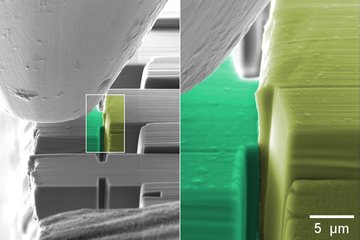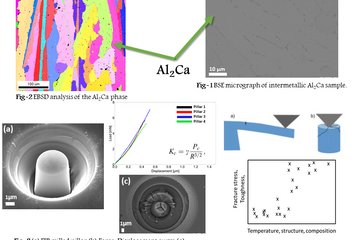All genres
521.
Teaching
Advanced Constitutive Models for Crystal Plasticity Simulations - Fundamentals, Implementation, Application. Lecture: Winter School 2014, Research Training Group 1483, KIT, Karlsruhe, Germany, March 18, 2014
522.
Teaching
Modellierung von Verformungsvorgängen auf Basis der Kristallplastizität. Lecture: DGM Fortbildung Modellierung und Simulation, ICAMS Bochum [Germany], November 18, 2011
523.
Teaching
Understanding the Elasto-Plasticity of Crystals. Lecture: MMM- Max-Planck Multiscale Simulation Conference, St. Feliu de Guixols [Spain], October 30, 2007
524.
Teaching
1) Design of new Ti-based biomaterials by using ab-initio simulations, FEM, and experiments 2) Detailed analysis of an indent. Lecture: AICES – MIT conference, RWTH Aachen, Germany, October 08, 2007
525.
Teaching
Crystal mechanics and recrystalliation models: Simulation for industry. Lecture: Internal Industry Conference, MPI für Eisenforschung GmbH, Düsseldorf, Germany
526.
Teaching
Crystal Plasticity and Fresh Lobster. Lecture: Lecture, BAM, Berlin, Germany, August 23, 2006
527.
Teaching
Micromechanics of Metallic Crystals and Fresh Lobster. Lecture: Lecture at MPI für Mikrostrukturphysik, Halle, Germany, 2006
528.
Teaching
Grain boundary mechanics in Crystal Plasticity Finite Element Modeling. Lecture: Breitnau Conference, Freiburg, Germany
529.
Teaching
Prozeß- und Werkstoffsimulation. Lecture: Lecture WS 2005/2006, RWTH Aachen, Germany, 2005 - 2006
530.
Teaching
Prozeß- und Werkstoffmodellierung; Aspekte der mesoskopischen und der Gefügesimulation. Lecture: WS 2003/2004: Vorlesung, Übung, Praktikum, RWTH Aachen, Germany, 2003 - 2004
531.
Teaching
Anisotropie, Textur, Umformtechnik.
532.
Thesis - PhD
On the role of dislocation transport in the constitutive description of crystal plasticity. Dissertation, RWTH Aachen, Aachen, Germany (2013)
533.
Thesis - Habilitation
Advanced material models for the crystal plasticity finite element method - Development of a general CPFEM framework. Habilitation, RWTH Aachen, Fakultät für Georessourcen und Materialtechnik, Aachen, Germany (2011)
534.
Report
Simulation of textures and Lankford values for face centered cubic polycrystaline metals by using a modified Taylor model. (2004)
535.
Report
A texture component crystal plasticity finite element method for scalable anisotropy simulations. MPI für Eisenforschung GmbH, Düsseldorf, Germany (2004)
536.
Report
A New Finite Element Method for Predicting Anisotropy of Steels. MPI für Eisenforschung GmbH, Düsseldorf, Germany (2004)
537.
Report
Finite element simulation of plastic deformation of steels. MPI für Eisenforschung GmbH, Düsseldorf, Germany (2004)
538.
Report
Introduction of a large-strain texture-based finite element method. MPI für Eisenforschung GmbH, Düsseldorf, Germany (2004)
539.
Other
Polykristalle in Form – Eine neue Kristallplastizitäts-Finite Elemente-Methode, (2004)
540.
Other
How do 10 billion crystals co-deform?, (2004)











